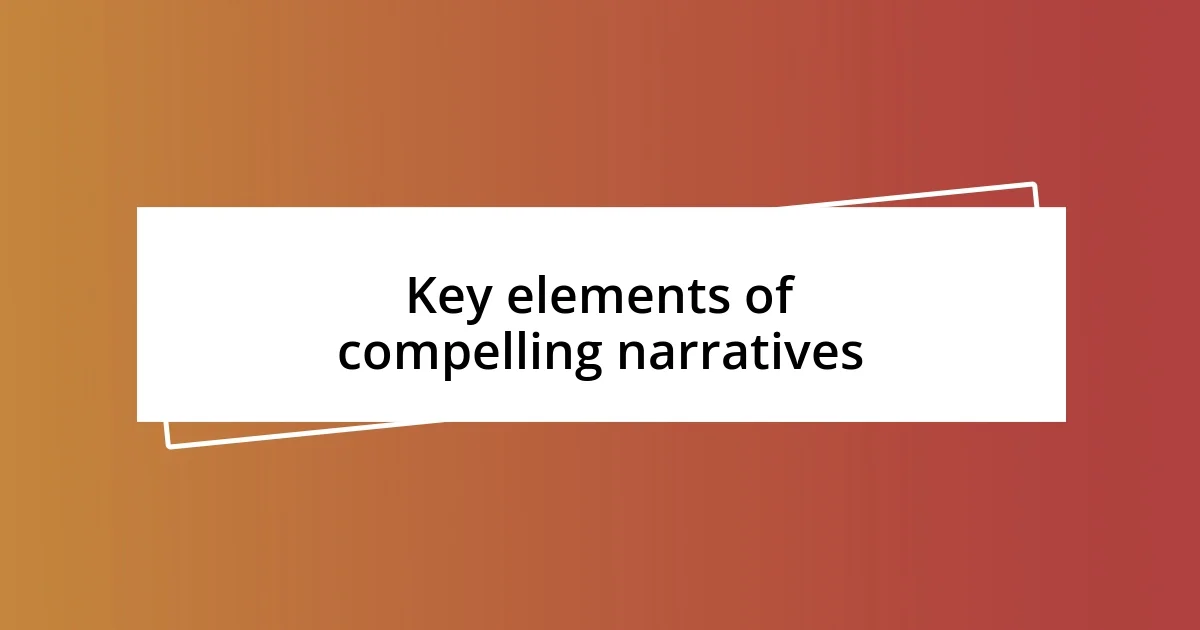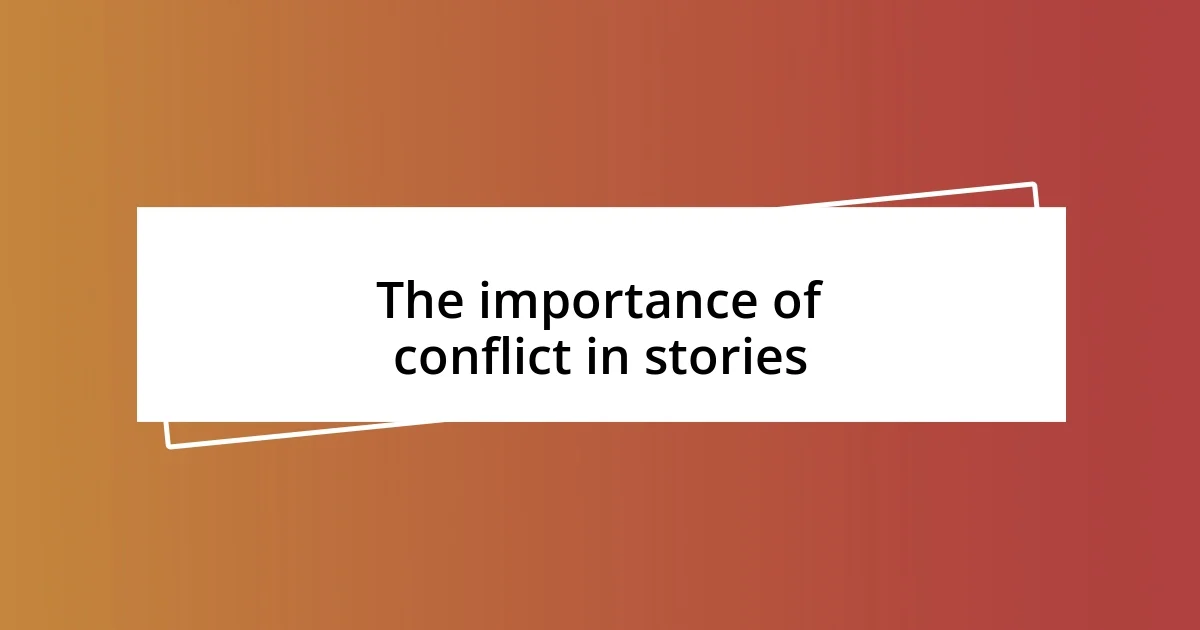Key takeaways:
- Netflix’s storytelling combines character-driven narratives with binge-worthy pacing, creating deep emotional connections through relatable characters and cliffhangers.
- Key elements of compelling narratives include relatable characters, conflict, pacing, universal themes, and resonance with real-life experiences.
- Effective resolutions tie up character arcs and reflect on personal growth, providing satisfaction and encouraging viewers to contemplate their own choices.

Understanding Netflix’s storytelling approach
Netflix’s storytelling approach showcases a masterful blend of character-driven narratives and binge-worthy pacing. I still vividly remember my first experience with “Stranger Things.” I found myself emotionally invested in the characters, almost as if I were part of their quest. It left me wondering, how did they manage to make me care so deeply so quickly?
The platform thrives on its ability to create cliffhangers that keep viewers coming back for more. I recall staying up late, unable to resist the urge to click “Next Episode” after an intense scene, feeling that rush of adrenaline and anticipation. This approach compels us to immerse ourselves not just in the plot but in the emotional rollercoaster the characters ride. Isn’t it fascinating how Netflix cultivates this depth of connection?
Moreover, the diversity of genres and unique narrative styles reflect a commitment to inclusivity and creativity. For instance, watching “The Queen’s Gambit” not only expanded my appreciation for chess, but it also highlighted the complexities of its protagonist, Beth Harmon. I found myself rooting for her in ways I hadn’t expected. Doesn’t that just illustrate how powerful storytelling can resonate across different aspects of our lives?

Key elements of compelling narratives
Compelling narratives hinge on strong character development. When I first watched “The Umbrella Academy,” I was struck by how each character’s backstory intricately tied into the plot, revealing their motivations and flaws. It wasn’t just their superpowers that captivated me; it was their vulnerabilities and growth that truly made the story resonate. This deep connection is often what transforms viewers into lifelong fans.
Here are some key elements that contribute to the power of storytelling:
- Relatable Characters: Audiences need someone to root for, flaws and all.
- Conflict: Tension drives the story forward, creating stakes that engage viewers.
- Pacing: The ebb and flow of action and emotion keeps the audience on the edge of their seats.
- Theme: A universal message adds depth and encourages viewers to reflect on their own lives.
- Resonance: Drawing from real-life experiences allows stories to connect on a personal level.
In every binge-worthy series, I find that these elements come together to form a narrative tapestry that captivates and encourages reflection, compelling us to hit “Next Episode” once more.

Characters and their development techniques
Characters are the heart of any story, and Netflix excels in their development techniques. Take “Ozark,” for example. I was drawn in by Marty Byrde’s moral dilemmas and gradual transformation from a mild-mannered financial planner to a cunning player in the criminal underworld. His evolution was not immediate; it felt organic, leaving me to reflect on how circumstances can change us. Have you ever watched a character struggle with their choices and found yourself questioning what you would do in their situation? I certainly have.
Another approach Netflix employs is the use of ensemble casts, as seen in “Orange Is the New Black.” Here, each character has a distinct backstory that not only enriches the narrative but also allows for a deeper understanding of the multifaceted nature of humanity. I found myself empathizing with characters I might have never considered, like the antagonist becoming more relatable through their struggles. This technique promotes a nuanced perspective, making us consider the layers that exist within every person.
A well-crafted character arc doesn’t just reveal transformations; it invites us on the journey. Watching a character face their fears or make decisions that align with their values can evoke strong emotions. I remember cheering for characters in “The Crown” as they navigated the challenges of leadership and personal sacrifice. Their developments mirrored real-life dilemmas, making me ponder my own choices. Isn’t it intriguing how characters can reflect our own experiences, offering both escapism and insight?
| Character Development Technique | Description |
|---|---|
| Backstory Integration | Characters are given rich histories that inform their motivations. |
| Ensemble Casts | Diverse characters with unique arcs allow for various perspectives. |
| Gradual Transformation | Characters undergo believable changes over time, often influenced by circumstances. |

The importance of conflict in stories
The essence of conflict is what drives a narrative forward, giving it life and urgency. I remember the gripping tension in “Stranger Things” as the characters faced both supernatural threats and personal struggles. This duality kept me on the edge of my seat, wondering how their relationships would evolve under pressure. Isn’t it fascinating how the stakes can elevate a story, making us invest emotionally in the characters’ fates?
When I think about conflict, I often reflect on how it forces characters to reveal their true selves. In “Money Heist,” characters like Berlin grapple with moral ambiguity and personal loyalty, forcing me to question my own values. How would I handle such situations? This interplay of conflict and character reveals profound truths about human nature, allowing us to explore facets of ourselves through fictional choices.
At times, the conflicts are not just external, but profoundly internal, as seen in “The Queen’s Gambit.” Beth Harmon navigates her addiction alongside her rise in the chess world. It’s a powerful reminder that sometimes the toughest battles are the ones we face within. Have you ever found yourself rooting for someone who is struggling against their own demons? It’s a relatable experience that can resonate deeply, drawing us into the narrative in ways we might not expect.

Creating tension and suspense effectively
Creating tension and suspense is all about the delicate dance of timing and stakes. A prime example is how “The Haunting of Hill House” meticulously unravels its mysteries, leaving breadcrumbs that twist and turn. Every cliffhanger had me binge-watching late into the night, as I found myself desperate to piece together the family’s dark history. Have you ever had that sleepless night because the story felt too gripping to pause?
What truly captivates me is the art of pacing. In “You,” the tension escalates with each episode as Joe Goldberg’s obsession deepens. Just when I thought I knew what would happen next, a plot twist would send my heart racing. This unpredictability keeps my engagement high, continually questioning the characters’ motives. How can a show so effectively disrupt my assumptions, making me both intrigued and uncomfortable?
Another technique I admire is the strategic use of silence or subtle moments. In “Narcos,” for instance, there are scenes where the absence of loud action is filled with suspenseful stillness. These moments force me to hang on every word, every glance, amplifying the tension without resorting to chaos. Isn’t it fascinating how sometimes less truly is more when it comes to suspense?

Crafting satisfying resolutions
Crafting a satisfying resolution is about tying up loose ends while leaving a lasting impression. When I finished “The Good Place,” I felt an overwhelming sense of closure. The way they wrapped up each character arc, addressing their growth and choices, made me reflect on my own life’s decisions. Isn’t it something special when a story makes you pause and think?
In contrast, I’ve experienced dissatisfaction when resolutions seem rushed or forced. I remember watching a series where the finale introduced new characters, complicating the storyline instead of resolving it. It left me frustrated, questioning why the writers didn’t dive deeper into the characters I had grown attached to. Why do some creators miss the mark on delivering a meaningful conclusion, while others excel at it?
What I’ve found particularly rewarding is when resolutions provide clarity without sacrificing nuance. Consider how “It’s Okay to Not Be Okay” beautifully explores the characters’ journeys, allowing their flaws and growth to breathe in the finale. It’s this balance of closure and ongoing struggle that resonates with me. Have you ever felt like a story ended just right, as if it perfectly mirrored the complexities of real life? That’s the magic of a well-crafted resolution.














